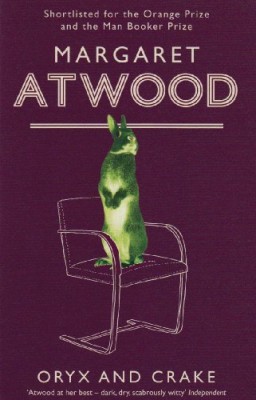Human society was a sort of monster

Oryx and Crake
by Margaret Atwood
When I saw that Margaret Atwood was coming to Bristol as part of the Festival of Ideas I got very excited about it and bought tickets. Only then did I realise that she is coming here to talk about her new book Maddadam, which is the third part of the trilogy that began with Oryx and Crake and Year of the Flood, and I had read neither of those. Cue a hurried purchase of both…
This dystopia is hauntingly desolate, a lonely existence for our hero Snowman, who may be the only human left, though not the only person. The devastation of society appears to be quite recent, as Snowman not only remembers the world as it was before, but played a key role in the tragedy, something that is gradually elucidated by his unreeling memories.
“The salt water is running down his face again. He never knows when that will happen and he can never stop it. His breath is coming in gasps, as if a giant hand is clenching around his chest – clench, release, clench. Senseless panic.
‘You did this!’ he screams at the ocean.
No answer, which isn’t surprising. Only the waves, wish-wash, wish-wash.”
However, the world as it was, the world Snowman knew before, back when he was Jimmy, was also a place that might be called a dystopia. Global warming was wreaking havoc, claiming coastal cities and changing climates unrecognisably, with widespread droughts and species becoming extinct with alarming frequency. Society in North America had become unruly and dangerous, with only those living in heavily guarded compounds safe from crime and disease.
“Too many things were coming back to him, too much of what he’d lost, or – sadder – had never had in the first place. All that wasted time, and he didn’t even know who’d wasted it.”
But how did the world change from there to here? Who are or were Oryx and Crake? Who are these people who look human but aren’t, called the Children of Crake, whom Snowman feels compelled to protect? And can he keep them safe in this post-civilisation Earth?
There’s a lot going on in this book. It’s a pretty complex set-up and I can see why it’s a trilogy, because there’s so much more that could be said with this setting. The central theme is an environmental one, pressing home the point that the Earth will go on, it’s humans who will lose out and risk making ourselves extinct if we continue to mess with our habitat. And in this respect it’s a very sad story, because what’s depicted is so believable.
“Maybe there weren’t any solutions. Human society, they claimed, was a sort of monster, its main by-products being corpses and rubble. It never learned, it made the same cretinous mistakes over and over, trading short-term gain for long-term pain.”
However, there is another major theme that is, perhaps, less believable, more sci-fi conceptual idea (and possibly saves the whole from being too preachy or moralising, or perhaps is actually more of the same). The pre-disaster society depicted is a world where genetic modification/bioengineering has gone to sometimes ludicrous extremes. I found this sometimes annoying, often strange, but ultimately it all makes sense.
The world we are left with is a beautiful but terrifying devastation, with nature reclaiming control, and I look forward to seeing where Atwood is going to take this next.
“Everything in his life was temporary, ungrounded. Language itself had lost its solidity; it had become thin, contingent, slippery, a viscid film on which he was sliding around like an eyeball on a plate. An eyeball that could still see, however. That was the trouble.”
Published 2003 by Bloomsbury.
Source: I bought it from Waterstones.
Challenges: This counts towards the Rory Gilmore Reading Challenge.
I loved both of these novels and am looking forward to Maddadam!